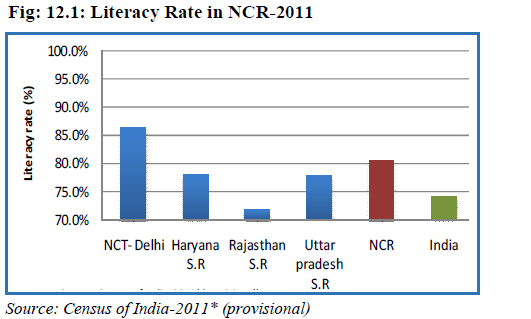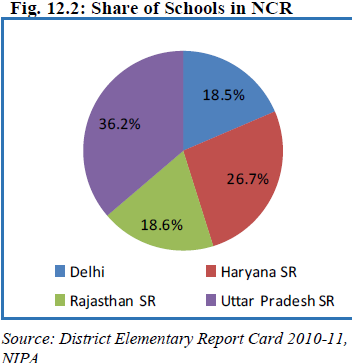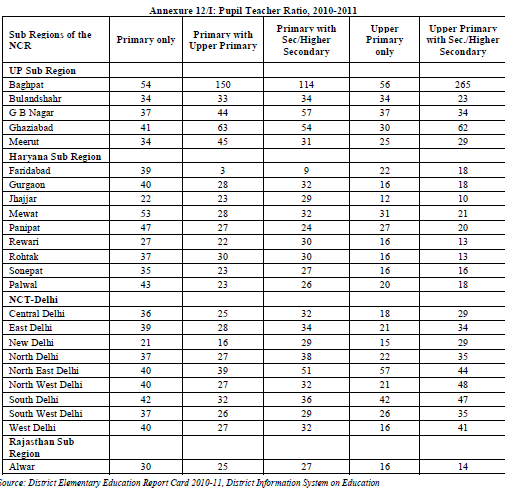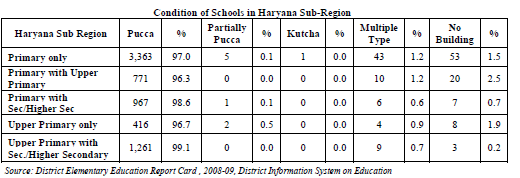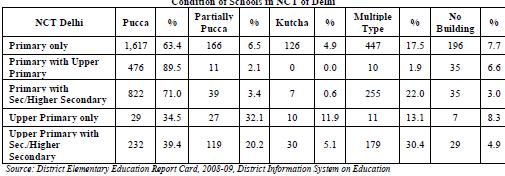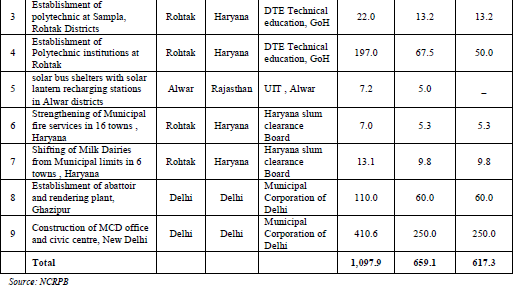National Capital Region (India): Education
This article has been sourced from an authoritative, official readers who wish to update or add further details can do so on a ‘Part II’ of this article. |
Contents |
The source of this article
Draft Revised Regional Plan 2021: National Capital Region
July, 2013
National Capital Region Planning Board, Ministry of Urban Development, Govt. of India, Core-4B, First Floor, India Habitat Centre, Lodhi Road, New Delhi-110003
National Capital Region Planning Board
National Capital Region(India) : Education
BACKGROUND
The Regional Plan-2021 for the National Capital Region (NCR) specifically recognised the growthstimulating and sustaining role of social infrastructure including education and health infrastructure in the regional development process. While physical infrastructure improves physical connectivity, the sustainability of economic growth and development is dependent on social infrastructure, more importantly education and health infrastructure.
Since NCT-Delhi has traditionally been a city with relatively better availability of educational infrastructure than rest of the NCR, 2.7% migration into Delhi (census 2001) has been observed on account of education. This sector therefore requires immediate steps to make NCR, outside NCT-Delhi, attractive for people in different regions/districts of the NCR. Such balancing is essential for even growth of the NCR. In NCR, CBSE and State Education Boards uniformly follow the "10+2+3" pattern of education. In this pattern, 10 years of primary (also referred to as Elementary education) and secondary education is followed by 2 years of higher secondary (usually in schools having the higher secondary facility, or in colleges), and then 3 years of college education for bachelor's degree. Ten years are further divided into 5 years of primary education and 3 years of upper primary, followed by 2 years of high school.
EXISTING SCENARIO
12.2.1 Existing situation of Educational Infrastructure in NCR
Literacy Rate- According to the Census 2011, the literacy rate in the NCR (80.4 percent) is higher than that of all India average of 74.0 percent. When compared among the Sub-regions, NCT-Delhi (86.3 percent) has the highest literacy rate followed by Haryana (78.2 percent), Uttar Pradesh (77.7 percent) and Rajasthan (71.7 percent) Sub-Regions (Fig 12.1).
12.2.2 Education facilities:
There are 28,284 schools in NCR out of which, 18,386 (65.0%) are Government schools and 9898 (35.0%) are private schools. Out of the 18386 government schools in NCR, 15659 are primary and upper primary schools, where as only 2727 schools are Secondary and Higher Secondary schools. The private sector has set up more secondary and higher secondary schools in NCR as compared to government agencies. Of the total 9898 private schools in NCR, 6689 are primary and upper primary school whereas 3209 schools are Higher Secondary schools.
The number of schools located in a particular area is the parameter for determining educational access. In the NCR, Uttar Pradesh Sub Region (10249 schools) has the highest number of schools, followed by the Haryana Sub Region (7541 schools), Rajasthan Sub Region (5255 schools) and then Delhi (5239 schools) (Fig 12.2 and Table 12.1).
In 2011, the population served by one school is the highest in Delhi (3198), followed by Haryana sub-region (1464) and Uttar Pradesh Sub-region (1423). The least population served per school’ ratio is in Rajasthan sub-region (699). Some of the Districts like Faridabad (2726), Gurgaon (1890), Panipat (1988) in Haryana sub-region and Ghaziabad (2155), GB Nagar (1518) in Uttar Pradesh sub-region have the highest population served per school’ in NCR. Districts like Rewari (921) and Alwar (699) have the least population served per school’ ratio. High ratio of one school per person may be attributed to the high density of population and large concentration of urban population in a compact area (Table 12.2).
Out of the total 5239 schools in NCT Delhi, 2772 schools (52.9%) are government schools and 2467 schools (47.1%) are private schools. There are 3201 primary and upper primary schools and 2038 secondary and higher secondary schools in Delhi (Fig 12.3).
In Haryana sub-region, out of the total 7541 schools, 5400 schools (71.6 %) are government schools and 2141 schools (28.4%) are private schools. There are 4980 primary and upper primary schools and 2561 secondary and higher secondary schools in Haryana sub-region.
In Rajasthan sub-region, out of the total 5255 schools, 3416 schools (65.0%) are government schools and 18391 schools (35.0%) are private schools. There are 4088 primary and upper primary schools and 1167 secondary and higher secondary schools in Rajasthan sub-region. In Uttar Pradesh sub-region, out of the total 10,249 schools in 6798 schools (66.3 %) are government schools and 3451 schools (33.7 %) are private schools. There are 10,079 primary and upper primary schools and 170 secondary and higher secondary schools in Uttar Pradesh Sub-Region.
12.2.3 Enrollments in Primary and Secondary Schools
Elementary education is the foundation of the pyramid of education system, stemming from provisions enshrined in the Directive Principles of State Policy and the 86th Amendment in the Constitution of India. The Sarva Shiksha Abhiyan (SSA), a flagship programme for Universalization of Elementary Education, has created awareness regarding the importance of elementary education. It envisages Universal Access and Enrollment to the formal Primary and Upper Primary Education system. Figure 12.4 shows the number of enrollments in the Primary and the Upper Primary Schools of the Sub Regions of the NCR from 2004 to 2011. It has been observed that the number of enrollments in the Primary level is comparatively higher than that in the Upper Primary Schools. At Sub Regional level it has been observed that the number of enrollments has increased tremendously in both the Primary and the Upper Primary Schools of the NCT of Delhi in the same period.
At district level it has been observed that Gross Enrollment Rates (GER) have drastically reduced during 2009 to 2011 in the districts of Faridabad (16.4) and Jhajjar (74.6) of the Haryana Sub Region and Central and North Delhi of NCTDelhi. The other constituent districts of the NCR have either registered a constant or an increasing GER. There has been a decline in the overall Gross Enrolment Rates (Table 12.3).
Gross Enrollment Ratio
The GER is the highest in Rajasthan sub-region where it was reported at 125 in 2010-11, next is NCT Delhi with 119, while in UP and Haryana Sub-region the ratio is 79 and 66 respectively. During the five years (2006-11) the GER has almost remained constant in Rajasthan sub-region while in Delhi it increased from 108 to 119 and in Haryana Sub-region also it increased from 49 to 66. However in UP sub-region the ratio has gone down from 83 to 79 during the same period.
In UP sub-region Bulandshahr district had the ratio of more than 100 % during 2006-07 and 2008-09 but after that it dropped to 88. Similarly, in Faridabad district the ratio dropped drastically from -
39 to 16 in the same period. However in other districts in NCR the trend shows increase in the gross enrollment rates.
12.2.4 Pupil Teacher Ratio (PTR) in the Primary and Upper Primary Schools of the NCR Right to Education Act (RTE) mandates an optimal student teacher ratio of 30:1 for all Indian Schools. If we consider the 2010-11 survey by the District Information System on Education (DISE) it is observed that the Pupil Teacher Ratio in the Baghpat district of UP Sub Region is higher than the other districts of NCR. Pupil teacher ratio is the highest in UP sub-region at every level from primary to higher secondary level i.e. 40:1 in primary level and 83:1 in Upper primary with secondary level, which is much higher than the norms of 30:1 stipulated in RTE. In Haryana sub-region, pupil teacher ratio is higher than the norm at primary school level, whereas at other level it is below the norm and the lowest of 16:1 at the upper primary and higher secondary level. In NCT-Delhi the ratio is in the range of norm except in upper primary and higher secondary level where it is 38:1. In Rajasthan sub-region the ratio is well below the norm. District wise Pupil Teacher Ratio is given in Annexure 12/I.
12.2.5 Provision of Infrastructure in the Schools Sarva Shiksha Abhiyan (SSA) focuses on provision of basic minimum facilities including physical infrastructure and availability of adequate number of teachers. There has been significant growth in school infrastructure under the SSA. An analysis of the DISE data (2008-2009) for the NCR reveals that in the UP Sub region almost 66 schools (3%) of the schools were running in the open without having any building of which almost 34 such schools were located in the Meerut district of the Sub Region. In addition in the Meerut district only, two schools were Kutcha and 23 were partially Pucca schools.
In the Haryana Sub Region 2 percent of each of the Primary and Upper Primary schools have no buildings. It has been observed that 52 schools in the Mewat district, 15 schools of Sonepat and 12 schools of Panipat district are having no building (Annexure 12/II). Similarly in the Rajasthan Sub Region 90 percent of the primary only schools and 92 percent of the Upper Primary only schools have Pucca structures. On the other hand 186 schools in the Alwar district of Rajasthan Sub Region are running without having a building. It has been observed that 63 percent of the Primary only, 35 percent of the Upper Primary only and 39 percent of the Upper Primary with Secondary/ Higher Secondary schools have Pucca buildings for running their schools. As a whole in NCT-Delhi 64.6 percent of the schools are Pucca, 7.4 percent partially Pucca, 3.5 percent Kutcha, 18.4 percent multiple type and 6.1 percent schools have no buildings.
Single Classroom Schools In the UP Sub Region the percentage of Single Classroom Schools is mostly lower than 1 percent. However in the Bulandshahr and Meerut districts, there is a high percentage of about 3.7 percent and 8.4 percent respectively of Single Classroom Schools at different levels of schooling. In the Haryana Sub Region the percentage of Single Classroom Schools in high (16 percent) for the Primary only schools. In the Rewari district 11.3 percent of the Upper Primary only schools are Single Classroom Schools. In the Alwar district of Rajasthan Sub Region 4.4 percent of the Primary only schools are Single Classroom Schools. In NCT-Delhi 3.5 percent of the schools in South West Delhi have Single Classroom.
Schools with Drinking Water facilities Except for the Rajasthan Sub Region, almost 100 percent of the schools in other sub regions have drinking water facilities. In the Alwar district of the Rajasthan Sub Region 85 to 97 percent of the schools have drinking water facilities.
12.2.6 Higher Education
In case of higher education it has been observed that the UP Sub Region has the maximum number of
General (279), Technical (336), and Medical (62) colleges as compared to the other Sub Regions of the
NCR. In the Haryana Sub Region it has been observed that around 434 Vocational Colleges have come up
in the recent years. In NCR, 1027 Vocational Colleges are running and imparting professional/ vocational
training to the people (Table 12.4).
